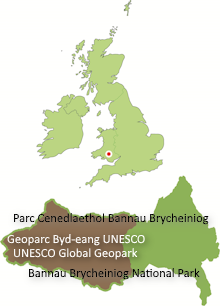The River Neath (Welsh: Afon Nedd) starts as the waters of the Nedd Fechan and Afon Mellte meet at Pontneddfechan then flow down the Vale of Neath to the sea at Swansea Bay. Several short but important rivers are found within the catchment, their flow punctuated by a multitude of waterfalls.
Nedd Fechan
The Nedd Fechan (Little Neath river) offers exceptional interest in its short course from the hills of Fforest Fawr to the Vale of Neath.
Rising at about 650m between the summits of Fan Gyhirych and Fan Fraith, the river turns south to flow over Old Red Sandstone rocks before disappearing into the ground when it reaches the band of Carboniferous Limestone. It shortly reappears and tumbles over a series of cascades and waterfalls formed by resistant bands of sandstone within what were traditionally known as the Millstone Grit Series of rocks (the ‘Marros Group‘ today). Foremost amongst these falls perhaps is Sgwd Ddwli, downstream of Pont Melin-fach.
The river merges with the Afon Hepste at Pontneddfechan to form the Afon Nedd or River Neath.
A former tramway running beside the river from behind the Angel Inn at Pontneddfechan gives access to its lower reaches and to its major west bank tributary, the Afon Pyrddin. The tramway once served a series of silica mines in the gorge. The adits (horizontal tunnels) can still be seen though should not be entered.
Afon Pyrddin
This river provides the Geopark with two of its finest waterfalls.
The name Afon Pyrddin may signify ‘river by the striking fortress’ or else ‘sweet-flowing river’. It is for the spectacular fall of Sgwd Gwladus that it is perhaps best known.
The river rises amongst the mix of open moorland and plantations east of Coelbren. It eventually enters a gorge section within which are the two falls of Sgwd Einion Gam and Sgwd Gwladus. The former is difficult of access but the latter is one of the most accessible of the area’s falls and repays a visit.
The river joins the Nedd Fechan at Pwll Du ar Byrddin (the ‘black pool of the Pyrddin’).
Afon Mellte
A river which can boast more impressive waterfalls than any other in the country.
The Afon Llia and the Afon Dringarth combine above Ystradfellte to form the Afon Mellte which flows on down to the Vale of Neath where on joining with the Nedd Fechan, the Afon Nedd or Neath River is born. The headwaters of the Llia and Dringarth are the Old Red Sandstone uplands of Fforest Fawr.
Afon Hepste
One of the few rivers with a public footpath running underneath it!
Starting as the Afon y Waun on the southern slopes of Fan Fawr, the river assumes the name of Afon Hepste when it is joined by the Nant y Cwrier. It follows a generally south-westward course to its meeting with the Afon Mellte but not before having plunged over the celebrated falls of Sgwd yr Eira.
Afon Sychryd
Short but adventurous – a small river which punches above its weight.
The Afon Sychryd is a short river which rises to the south of the Geopark -in fact the only one of the Nedd’s tributaries to do so – and heads through a deep wooded gorge for a meeting with the Afon Mellte near Craig-y-Ddinas / Dinas Rock. This cliff-defended tongue of rock between the two rivers is the site of an Iron Age promontory fort and gives the feature its name; Craig-y-ddinas signifies ‘fortress of the rock’.
The most spectacular part of its course, immediately below Craig-y-Ddinas is guided by the fault zone of the Neath Disturbance where, as Sgydau Sychryd, it cascades though a narrow slot between rock walls. Just below the cascades, the strongly folded limestones of Bwa Maen tower above its waters.
Spectacular geology
There are few places in South Wales where the geological upheavals of the past are more strikingly displayed than along the course of the Sychryd. The main gorge section has been carved out by the river along the Dinas Fault, where movement of the rocks on either side has fractured a broad band of rocks and made them more prone to erosion by water. There are at least a couple more parallel faults to the north of Dinas Rock which, together with associated folds in the rocks, are collectively known as the Neath Disturbance. The Dinas Fault Zone is effectively the entire width between the sheer walls of Dinas Rock and Bwa Maen and which contains a multiplicity of movement planes – surfaces which have slid past each other in the past.
The great prow of rock known as Bwa Maen (literally the ‘stone arch’ or ‘stone bow’) is an extraordinary, tightly folded block of Carboniferous Limestone. It can best be seen in winter from near the end of the Sychryd all-ability trail when the vegetation has died back.
The Neath Disturbance is one of several such ancient weaknesses in the Earth’s crust in South Wales. It can be traced southwest down the Vale of Neath to Swansea Bay and northeast through Moel Penderyn, Cwm Cadlan and on along the valley north of Sugar Loaf to die out somewhere just to the south of Hereford. It was probably active during both the Caledonian Orogeny and the later Variscan Orogeny – an orogeny is a mountain-building period generally associated with colliding continents. Each time it moved, an earthquake shook the region. It is thought that the 1906 Swansea earthquake, centred on Swansea Bay, may have occurred as a result of movement on this fault.
Industrial legacy
Step back in time a few decades and this place was a hive of industry. Thousands of tons of solid rock were mined from either side of the Sychryd Gorge leaving a honeycomb of caverns beneath its wooded sides. Walkers exploring its steeply wooded slopes today may come across some of the many entrances to these caverns.
Do not be tempted to enter the mines as they are hazardous – there are steep drops in the dark whilst parts are now flooded and there have been roof-falls in some places.
The miners were after the ‘basal grit’, a particularly hard band of rock we know today as the ‘Twrch Sandstone’, but they would have referred to it as the ‘silica rock’ for that is what it was – over 98% pure silica (silicon dioxide or Si02) otherwise known as quartz. Once it had been crushed to powder and re-shaped as bricks it would be fired in a kiln to form refractory bricks or firebricks used to line the furnaces of the iron and steel smelters of industrial South Wales. These bricks came to be known as ‘Dinas Bricks’ and, in at least one of the countries to which these bricks were exported – Russia – the word ‘dinas’ came to mean ‘firebrick’.
An aerial ropeway stretched high over the Sychryd gorge carrying the lumps of mined rock down to the Dinas Rock from where they were transported to the brickworks at Pontwalby. A system of tramways was also in use in the area to transport the mined material. A steep ramp supported on iron pillars linked tramways above and below the main Sychryd cascade. The stumps of these pillars are still visible today.
Ancient boundary
The river forms a part of the boundary between the modern day local government areas of Powys and Rhondda Cynon Taf. Before 1974 this was the historic boundary between the counties of Brecknockshire to the north and Glamorgan to the south. In even earlier times it marked the edge of the kingdoms of Brycheiniog and Glywysing (later Morgannwg). Since 1957 it has also served as the boundary of the Brecon Beacons National Park and, since 2005 has been the Fforest Fawr Geopark boundary too.
Enjoy it!
The Sychryd All-ability Trail follows the lower reaches of the river from Dinas Rock car park as far as Bwa Maen and Sgydau Sychryd. The trail follows the course of a former tramway which once served the Dinas Silica Mine.



